Amphiboles (silicates): debate
 Diagnostic Card.
Diagnostic Card.
In the photo - a debate in a quartz geode from Tiso, Val di Funes (Bolzano province). Bottom: white with yellow prehnite tabular prismatic crystals of epidote.
Ca 2 Al 2 (OH) 2 Si 3 O 10
Crystal system orthorhombic
Hardness 6-6.5
The proportion of 2.8-3
Cleavage is perfect
The break in the wrong
Colour colorless, differently colored
Color white powder
Gloss glass

Prehnite - aluminosilicate. Gloss glass to pearl. Translucent, sometimes transparent. Colours: yellow, green, white; It is colorless. The bar is white. Fracture is uneven. Cleavage is perfect. Formed in cracks and cavities drusy. Crystals (orthorhombic system) are rare, there are tabular, prismatic, but the most common fan-shaped growths tonkoplastinchatyh needle or individuals. There are twins. Distribution Area: Harz (Germany, Germany), Black Forest (Germany), the Alps, Scotland.
Typically, there are aggregates of crystals. Prehnite is unstable when heated (caution when soldering!). Known prenitovy cat's eye. It is found in Australia (New South Wales), China, Scotland, South Africa, USA (pcs. New Jersey). Prehnite can be confused with chrysoprase, jade, peridot.
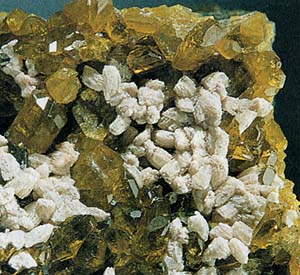 Prehnite occasionally occurs as single crystals or small groups. The crystals are tabular or prismatic, often twisted or deformed faces. Much more often, however, there are aggregates of the mastoid, or kidney-shaped stalactite forms part of the radiant-fiber structure. They can reach impressive sizes - up to tens of centimeters in diameter.
Prehnite occasionally occurs as single crystals or small groups. The crystals are tabular or prismatic, often twisted or deformed faces. Much more often, however, there are aggregates of the mastoid, or kidney-shaped stalactite forms part of the radiant-fiber structure. They can reach impressive sizes - up to tens of centimeters in diameter.
As a rule, the debate is colorless or grayish-white in color, but it happens occasionally painted in green, gray-green, yellow-green tones. Some units of coloring is distributed unevenly, forming irregular spots. Gloss glass, especially microcrystalline aggregates; rarer completely transparent crystals.
The crystals are rare, often tabular, prismatic also often curved, assembled in groups which resemble a fan, and a cockscomb or have a spherical shape. There are also shelly, kidney-shaped, spherical aggregates. Cleavage is clear; density of 2.8-3.0; white, mostly light or yellowish green, colorless.
The unit cell parameters and the number of formula units, a = 4.61, b = 5.47, c = 18.48; Z = 2. Habit. The rare form of crystals; usually pseudocubic or tabular parallel {001}; massive, spherical or stalactite with the crystal surface. Cleavage. In {001} good. Optical properties. Anisotropic, biaxial (+), 2V = 60-70 o . The refractive indices: np = 1,610-1,637, nm = 1,615-1,647, nq = 1,632-1,673. The chemistry. Fe3 + can substitute for Al3 + 8% Fe2O3.
Diagnostic features.
Slowly dissolved in hydrochloric acid and is easily melted by a flame, forming a mass of glass bubble-white or light yellow. Characterized by a pale green, but in some samples of white or gray color.
Origin.
Distributed in various formations, for the most part as a secondary mineral. Often found in rocks of basic composition (especially in the gabbro and diabases), amphibolites, schists; at least - in the cavities of granite; occasionally it is found in the cracks of marble, limestone and dolomite. Like the zeolites, secondary or hydrothermal product in gas cavities, cracks, geodes and veins and bedrock schists.
Place of Birth.
If we talk about Italy, the debate is found in many alpine areas. Material suitable for jewelry use, installed in Prospect Kuorriz near Sydney (Australia), Namaqualand (South Africa). Deposits: Germany (Palatinate, the Black Forest, Hesse et al.), Austria (Tyrol), France (Dauphine, Pyrenees), Italy, Scotland, the United States (New Jersey, rock-forming mineral traps, lakes ore district of the Upper, with zeolites and native copper). Clear crystals gemstone quality are in New South Wales (Australia), China, Scotland, South Africa, USA.
The use in jewelry.
Widely used in cabochon cut, which reveals the effect of iridescence. Of the many copies of gem produced, moreover, polished sphere and preform for making suspensions and necklaces. Occasionally, if you can get crystal clear, it is treated with facets, usually plate or stepped cut. From the very dense and homogeneous units make intaglio or small sculptures.
First, documented mention of a mineral refers to 1777, when the French mineralogist BJ Sage described the clear weight of chrysotile from the Cape of Good Hope. In 1783, Dutch Colonel van Pren mineral brought from South Africa to Germany, where Werner has identified it as a new and gave him a name. Transparent crystals are now polished like jewels. Similar minerals Vavvelit, Staffel, Thomson, stilbene heulandite may be similar to prehnite; polished as a cabochon, the debate is similar to chrysoprase, jade, peridot.

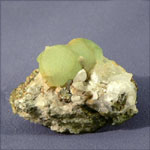

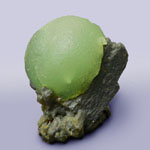
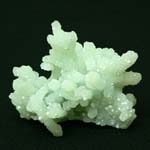


Debate. "Cape of Good Hope", Yuzhn. Africa. Photo: © AA Evseev.
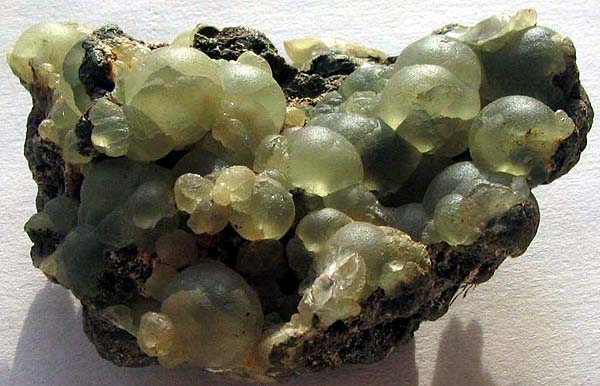
Debate. Toningda b n p. Lower. Tunguska, Russia. Photo: © AA Evseev.
- Gatchell - "New Almadén snag" - arsenide and antimony sulfide (modern sulphosalts)
- Antimony - toxic metal (semi-metal) are widely used in industry, medicine and engineering
- Zirconium - a rare and non- metal and dangerous jewel in the oxide and salts
- Gold - yellow dangerous and toxic metal -date and accurate digital cable technology
- Sulphur - a golden-yellow toxic substance and a sign of volcanic activity
- Cadmium - a toxic uncirculated unknown wide range of people silvery metal
- Lead - a poisonous gray simulator silver metal and toxic metal snag
- Arsenic - poison classic medieval and modern poisoners and medicine in medicine
Toxic and hazardous radioactive rocks and minerals
** - Poisonous stones and minerals (obligatory check in chemical laboratory + clear indication of toxicity)
** - Radioactive rocks and minerals (obligatory check on a regular dosimeter + ban on the open sale of radioactivity in the event of more than 24 mR / hour + additional measures to protect the population)
Catalog minerals and gems in groups of the world
** - Poisonous stones and minerals
** - Radioactive rocks and minerals


Comments
Commenting, keep in mind that the content and the tone of your messages can hurt the feelings of real people, show respect and tolerance to his interlocutors, even if you do not share their opinion, your behavior in terms of freedom of speech and anonymity offered by the Internet, is changing not only virtual, but real world. All comments are hidden from the index, spam control.